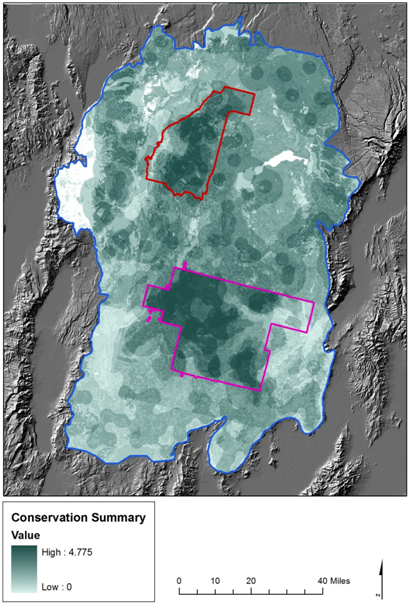Vista was used to spatially assess the cumulative impacts of management activities and stressors arising from infrastructure and other land uses, including roads, energy development, cattle grazing, and the use of wild horses and burros. Other tools (Vegetation Dynamics Development Tool combined with climate models (MC1) were used to assess the impacts of various grazing management scenarios and juniper control treatments on vegetation distribution with and without the projected effects of climate change. Vista was then used to integrate assessment information and demonstrate development and evaluation of alternative landscape management scenarios.
This project—which used NatureServe's Vista tool—assessed the cumulative impacts of stressors on refuge resources over multiple timeframes to provide information on how priority resources (e.g., pronghorn, sage grouse, sagebrush habitat) on the Refuge Complex and the surrounding landscape may be affected by various management activities and land uses in the context of a changing climate. The results can inform the identification of mitigation and adaptation strategies that could address those impacts, both on and off the refuges.
 The Vista results illustrated that reduction or elimination of cattle grazing and wild horse and burro use can have beneficial effects for refuge resources, including many of the habitat types and all of the rare plant species. Similarly, the VDDT and climate models indicated that juniper control and reduced cattle grazing may have beneficial impacts on native habitat types, although in the latter part of this century, the changing climate is projected to push vegetation away from sagebrush habitat and toward grassland habitat regardless of changes in grazing and juniper control. The results were used and incorporated in the new Comprehensive Conservation Plan for the refuges.
The Vista results illustrated that reduction or elimination of cattle grazing and wild horse and burro use can have beneficial effects for refuge resources, including many of the habitat types and all of the rare plant species. Similarly, the VDDT and climate models indicated that juniper control and reduced cattle grazing may have beneficial impacts on native habitat types, although in the latter part of this century, the changing climate is projected to push vegetation away from sagebrush habitat and toward grassland habitat regardless of changes in grazing and juniper control. The results were used and incorporated in the new Comprehensive Conservation Plan for the refuges.